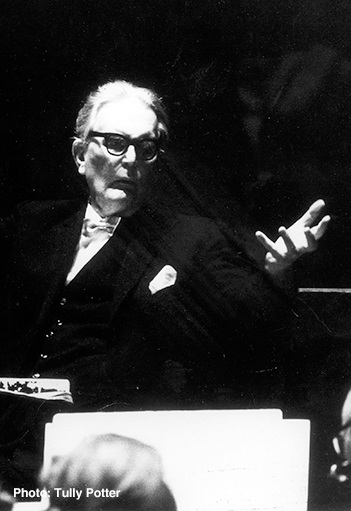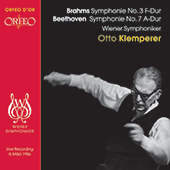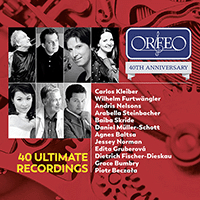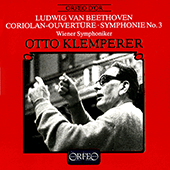Otto Klemperer
Klemperer’s father was a businessman and his mother a piano teacher. When he was four years old, the family moved to Hamburg, where he was educated at the Realgymnasium des Johanneum, subsequently entering the Hoch Conservatory at Frankfurt in 1901 to study piano with James Kwast and music theory with Iwan Knorr. When Kwast moved to Berlin during the following year to teach at the Klindworth-Scharwenka Conservatory, Klemperer followed him, studying in addition composition and conducting with Hans Pfitzner. Klemperer directed the off-stage chorus in a performance of Mahler’s Symphony No. 2 conducted by Oskar Fried in 1905, at which the composer was present, and went on to make his professional debut in 1906 substituting for Fried in Max Reinhardt’s production of Offenbach’s Orphée aux enfers, which he conducted for fifty performances.
Having made a piano reduction of the scherzo from Mahler’s Symphony No. 2, Klemperer played this to the composer while on tour in Vienna. Mahler was sufficiently impressed to give him a written recommendation enabling him to obtain the post of chorusmaster and conductor at the German Theatre in Prague in 1907. While working in Prague, Klemperer visited Vienna to assist at the rehearsals of Mahler’s later symphonies, and with Mahler’s support he secured the position of first conductor at the Hamburg Opera in 1910, where he remained until 1912. This was followed by appointments at Bremen (1913–1914), and Strasbourg, where he assisted Pfitzner (1914–1917); he was subsequently appointed chief conductor at Cologne (1917–1924) and Wiesbaden (1924–1927). After World War I, Klemperer was soon recognised as one of the leading conductors of his generation, developing a reputation for his interpretations of Bruckner and of contemporary music: while at Cologne he conducted the first performances of Korngold’s Die tote Stadt, Schreker’s Irrelohe and Zemlinsky’s Der Zwerg as well as the first German performance of Janáček’s Kát’a Kabanová. He began to receive many invitations to guest-conduct abroad, visiting Barcelona (1920), Rome (1923), Moscow (1924), Leningrad (1925), New York (1926) and London (1928).
In 1923, Klemperer was approached to become chief conductor at the Berlin Staatsoper, but declined on the grounds that the artistic freedom which he wanted might not be forthcoming. However four years later in 1927 he accepted the post of chief conductor at the newly-established Kroll Opera, a division of the Staatsoper which was set up in Berlin to perform new works and repertory operas in original productions. Although this brave experiment lasted only four years, under Klemperer’s leadership it exerted a decisive influence upon the course of twentieth-century opera: works performed there included Hindemith’s Cardillac, Janáček’s From the House of the Dead, Schoenberg’s Erwartung, Stravinsky’s Oedipus Rex, and Weill’s Der Jasager; while productions of established operas, for instance that of Wagner’s Der fliegende Holländer, were to exert a strong influence upon young directors such as Wieland Wagner. Klemperer himself was active as a stage director as well as a conductor, creating productions of Don Giovanni, Fidelio and Stravinsky’s Mavra. Following the closure of the Kroll Opera in 1931 Klemperer conducted at the Berlin Staatsoper until 1933, when he emigrated to the USA.
Between 1933 and 1939, Klemperer was chief conductor of the Los Angeles Philharmonic Orchestra, appearing also with the New York Philharmonic and Philadelphia Orchestras as well as assisting with major changes at the Pittsburgh Symphony Orchestra during 1937 and 1938. He was partially incapacitated in 1939 when he underwent an operation for a brain tumour. This left him semi-paralysed, unable to hold a baton and conducting only infrequently. After the end of World War II, Klemperer returned to Europe, conducting as a guest in France, Italy, Sweden and Switzerland as well as in London in 1948, appearing here for the first time with the Philharmonia Orchestra. Between 1947 and 1950, he was chief conductor at the Budapest Opera, but relinquished this post following political interference in Hungary and a successful tour of Australia in 1950.
During the early 1950s, Klemperer had made several highly influential recordings for the Vox label which clearly demonstrated his stature as a conductor of the traditional repertoire and of the music of Bruckner and Mahler in particular, but the most significant event in his recording career came in 1954, when he signed a contract, negotiated by Walter Legge, to make recordings for EMI with the Philharmonia Orchestra: he was to be closely associated with this label and orchestra for the rest of his life (he also made a single recording for EMI with the Orchestre National de Radio France). Klemperer’s EMI discography was very large and much of it has remained consistently in the catalogue.
He was appointed the Philharmonia Orchestra’s ‘principal conductor for life’ in 1959; and when, following Walter Legge’s decision to disband it, the orchestra was reorganised as a players’ co-operative in 1964 under the name of the New Philharmonia Orchestra, he became its president. Klemperer made his debut at the Royal Opera House, Covent Garden in 1961, conducting and directing Fidelio. So great was his success that after the final performance the intendant of the opera house, Sir David Webster, presented him with a laurel wreath with a note saying ‘You have conquered Covent Garden’ which Klemperer carried with him for many years afterwards; he returned there to conduct legendary productions of Die Zauberflöte (1962) and Lohengrin (1963). Despite increasing frailty, not helped by a succession of accidents, Klemperer continued to conduct in public until 1971, often with the most minimal of gestures but with huge personal authority. His laconic sense of humour and international stature were both well epitomised by his comment towards the end of his life: ‘I am the last of the classical school – when Bruno Walter died, I put my fees up.’ Following his death his large recorded legacy has resulted in his reputation remaining secure within the pantheon of truly great twentieth-century conductors.
As an interpreter Klemperer was less interested in beauty of sound than in forceful projection, clarity of texture, and a cumulative power that stemmed from an unwavering sense of rhythm. His feeling for musical form and architecture was complete, while his conducting style was noticeably unflamboyant. These characteristics gave his readings of the music of composers such as Beethoven, Brahms and Bruckner an epic quality that during Klemperer’s lifetime defined for many people the essential character of these composers. In the evocative words of the American critic, Joseph Horowitz: ‘Klemperer’s most characteristic performances, rigorously projecting outward design, amassed a magisterial poise and weight.’ His interpretations of the music of Mahler were completely without sentiment, in stark contrast at times to those of another distinguished Mahler assistant, Bruno Walter, raising the interesting question of whether there might be any authentic Mahler ‘style’ of performance.
Klemperer recorded largely out of economic necessity and a marked difference exists between his commercial recordings and recordings of his live performances. Nonetheless, many of his studio recordings are of the first rank. Outstanding among them are his first monophonic recordings of Beethoven’s Symphonies Nos. 3, 5 and 7, made in 1954; the four Brahms symphonies; Bruckner’s Symphonies Nos. 4, 6 and 7; Mahler’s Symphony No. 2 and song-cycle Das Lied von der Erde, to name just a few. His powerful readings of Stravinsky’s Symphony in Three Movements and of Weill’s Kleine Dreigroschenmusik, which he commissioned, give some indication of the character of his Kroll Opera interpretations. While Klemperer’s studio recordings of operas have considerable power, recordings of contemporaneous live performances, such as those of Fidelio and Der fliegende Holländer, have greater character and cumulative dramatic impact, as have certain symphonic performances, notably his apocalyptic reading of Mahler’s Symphony No. 2 from the Holland Festival of 1951 with Kathleen Ferrier. Klemperer was also an intermittent composer and his recordings of his Symphony No. 2 and the Merry Waltz from his opera Das Ziel reveal, as did his conducting, a musician of great character and individuality.
© Naxos Rights International Ltd. — David Patmore (A–Z of Conductors, Naxos 8.558087–90).




















